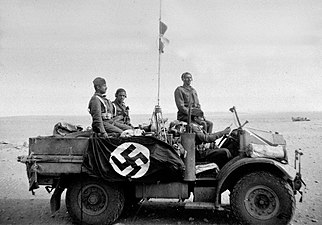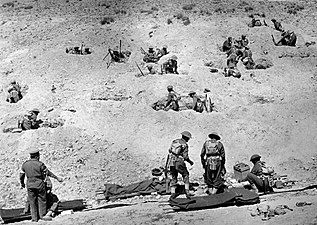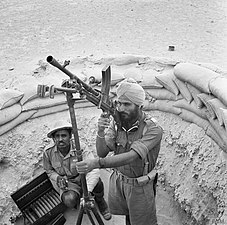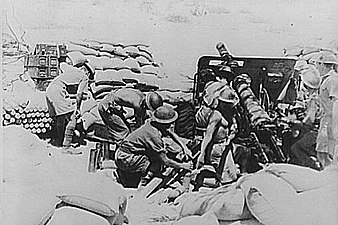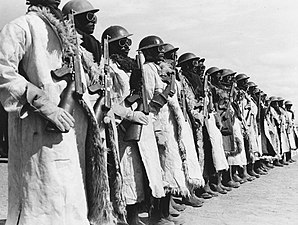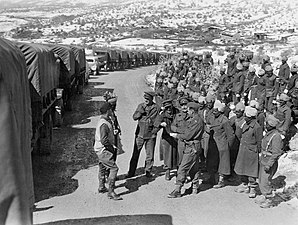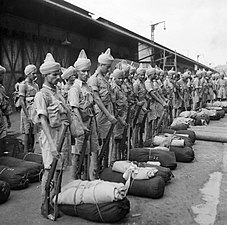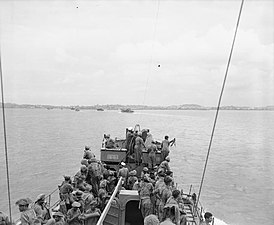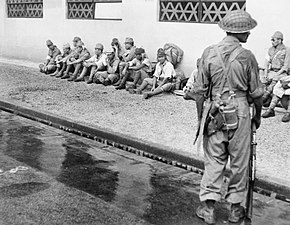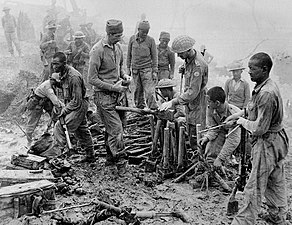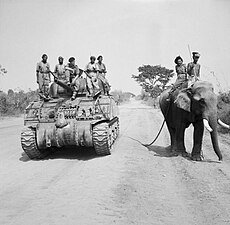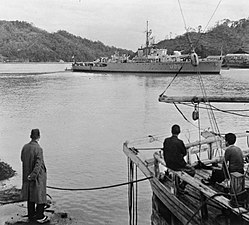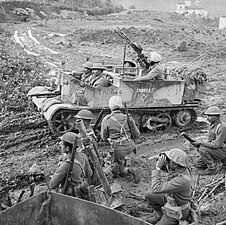Indian Army during World War II
| Indian Army | |
|---|---|
  New Indian Army recruits | |
| Active | 1895–1947 |
| Country | |
| Allegiance | |
| Type | Army |
| Size | 2.5 million men |
| Headquarters | GHQ India (Delhi) |
| Commanders | |
| Notable commanders | Archibald Wavell, 1st Earl Wavell Claude Auchinleck |
The Indian Army during World War II, a British force also referred to as the British Indian Army,[1] began the war, in 1939, numbering just under 200,000 men.[2] By the end of the war, it had become the largest volunteer army in history, rising to over 2.5 million men in August 1945.[2][3] Serving in divisions of infantry, armour and a fledgling airborne force, they fought on three continents in Africa, Europe and Asia.[2]
The army fought in
Background
In 1939, the Indian Army was an experienced British force, having fought in the
In 1939, British officials had no plan for expansion and training of Indian forces, which comprised about 130,000 men (in addition, there were 44,000 men in British units in India in 1939). Their mission was internal security and defence against a possible Russian threat through Afghanistan. As the war progressed, the size and role of the Indian Army expanded dramatically, and troops were sent to battle fronts as soon as possible. The most serious problem was lack of equipment.[8]
Organization

The Indian Army of 1939 was different from the Indian Army during World War I (also a British force); it had been reformed in 1922, moving away from single battalion regiments to multi-battalion regiments.[9] Overall, the army was reduced to 21 cavalry regiments and 107 infantry battalions.[10] The field army now consisted of four infantry divisions and five cavalry brigades.[11] There was a covering force of 12 infantry brigades to protect the North West Frontier from incursions and one third of the infantry, 43 battalions, were allocated to internal security and to aid the civil power.[11] In the 1930s, the Indian Army began a programme of modernisation—they now had their own artillery—the Indian Artillery Regiment—and the cavalry had started to mechanise.[12] By 1936, the Indian Army had committed to supplying in wartime a brigade each for Singapore, the Persian Gulf, the Red Sea, Burma and two for Egypt.[13]
But, by 1939, further reductions had reduced the Indian Army to 18 cavalry regiments and 96 infantry battalions, in total 194,373 men including 34,155 non-combatants.
There were twenty two regular regiments of cavalry, which supplied tank and armoured car units. (Seven more were raised during the war.) There were twenty regular Indian regiments of infantry (including the Burma Rifles) and ten Gurkha regiments. Before the war, all the Indian regiments had at least two battalions, and most had more. The Gurkha regiments had two battalions each. During the war, the Gurkha regiments raised a further two battalions each, while the Indian regiments raised up to fifteen each. Two further regiments (the Assam Regiment and the Burma Regiment) were created during the war.
The Indian Army started World War II underprepared and short of modern weapons and equipment.
1940
In May 1940, agreement was reached between the British and Indian governments over the formation of another five infantry and one armoured divisions, which became the 6th, 7th, 8th, 9th, 10th infantry and the 31st Indian Armoured Divisions.[15] These new divisions were primarily intended to be used in the defence of Malaya (9th Division) and Iraq (6th, 8th and 10th Infantry divisions).[15] The 3rd Indian Motor Brigade, from the armoured division, was to go to Egypt; the formation of the rest of the armoured division was put on hold, because of the shortage of armoured vehicles.[15]
1941
In March 1941, the Indian government revised the defence plan for India. Concerned with what the Japanese were planning and the requirement to replace the divisions sent overseas, seven new armoured regiments and 50 new infantry battalions were needed for five new infantry divisions that were formed: the
1942
With the fall of Singapore in 1942, about 40,000 Indian soldiers were captured. They were given a choice; 30,000 joined the Indian National Army. Those who refused became POWs and were mostly shipped to New Guinea.[17]
With the previously formed divisions mostly committed overseas in 1942, the army formed another four infantry divisions (
After the perceived poor performance in battles in Malaya and Burma in 1942, it was decided that the existing infantry divisions were over–mechanised. To counter this, the 17th and 39th divisions were selected to become light divisions, of only two brigades which would rely more on animal and four-wheel-drive transport.[18]
By December 1942, agreement was reached that India should become the base for offensive operations. Support should be in place for 34 divisions, which would include two British, one West African, one East African and eleven Indian divisions, and what was left of the Burma Army.[19]
1943
The plans for 1943 included the formation of another infantry division, an airborne division and a heavy armoured brigade. Only the 44th Indian Armoured Division was formed, by amalgamating the 32nd and 43rd Armoured divisions.[18] There was a change to the establishment of infantry divisions, which received two extra infantry battalions as divisional troops.[18]
A committee was set up in 1943 to report on the readiness of the army and suggest improvements. Its recommendations were:
- The infantry should have first claims on cadet officers and educated recruits, the quality of officers and non commissioned officers (NCO) should be improved and there should be an increase in pay.
- Basic training should be increased to nine months followed by two months' specialised jungle training.
- The reinforcement system should be improved and drafts should include experienced NCO's
- Infantry brigades should include a British, an Indian and a Gurkha battalion.[20]
To assist in the jungle training of the infantry from July 1943, the 14th and 39th divisions were converted to training divisions.
1944
The planned 44th Indian Airborne Division was finally formed from the 44th Armoured Division, leaving the 31st Armoured as the only armoured division in the army.[18] The infantry division formation was changed again; it was now standardised as three infantry brigades plus three infantry battalions assigned as divisional troops.[18]
The success of the 116th Brigade in training for jungle warfare was recognised. From May 1944, 116th Brigade trained units destined for the Fourteenth Army and 150th Brigade, which was converted from the Risalpur Training Brigade, trained units destined for the Southern Army.[22] The 155th Indian Infantry Brigade was formed to provide training for units destined for the western theatres of war.[20]
Infantry divisions
Infantry divisions consisted of three infantry brigades, of three infantry battalions. Usually, one battalion in each brigade was British and two were Indian or Gurkha. Four brigades were raised consisting entirely of Gurkha battalions. Later in the war, as British infantry reinforcements became more scarce, particularly in the South East Asian Theatre, British battalions in brigades fighting in Burma were replaced by Indian units.
In a division with a standard MT (Mechanical Transport) establishment, the divisional units were a reconnaissance unit provided by a mechanised cavalry regiment, and a heavy machine gun battalion armed with thirty-six Vickers machine guns. (Each Indian infantry regiment raised a machine gun battalion in addition to its infantry battalions.) The divisional artillery consisted of three field artillery regiments with twenty-four 25-pounder guns each, one anti-tank regiment with forty-eight anti-tank guns and one light anti-aircraft regiment with up to fifty-four light anti-aircraft guns. There were three engineer field companies and one engineer field park company, plus signals, medical and transport units.[23]
There were variations on the infantry formation, depending on role. The light divisions (14th, 17th and 39th) as formed in 1942 had only two brigades and lacked much heavy equipment. Transport was provided by six mule and four
On 27 May 1944, General
Armoured divisions
It was intended to form an armoured division in the plans for 1940, 1941 and 1942. However, the Indian armoured formations suffered from a lack of equipment. The shortage of tanks in 1940 was reflected in the organisation of 31st Armoured Division, which first had one armoured and two motor brigades. At the end of 1940, this was changed to two armoured and one motor brigade.[28] When the 3rd Indian Motor Brigade was sent to Egypt, the British armoured division organisation of two armoured brigades and a Support group was adopted.
In June 1942, the division's establishment was fixed as one armoured and one infantry brigade. The surplus armoured brigades (
Airborne troops
The
The headquarters of the 44th Indian Armoured Division was converted in April 1944, to
Artillery
The Royal Artillery still provided some of the artillery required for Indian Army formations, but the Indian Regiment of Artillery had been formed in 1935, initially consisting of four horse–drawn batteries.[34] The regiment was expanded during the war and, by 1945, had formed 10 field artillery regiments, 13 mountain artillery regiments, 10 anti–tank artillery regiments. Three anti–aircraft brigades were formed from the four heavy anti–aircraft artillery regiments and five light anti–aircraft artillery regiments created.[35] For the regiments service during the war, it was granted the title Royal Indian Artillery in 1945.[34]
Engineers
The
Women's Auxiliary Corps (India)

The Women's Auxiliary Corps (India) was formed in May 1942; recruits had to be a minimum age of 18 years and their duties were clerical or domestic. In December 1942, the minimum age was reduced to 17 years and 11,500 women had enlisted by the end of the war.[28] Volunteers could enlist on Local service or General service terms. Those on General service could be sent to serve anywhere in India.[37] Compared to over two million men, the corps of 11,500 women was small, but recruitment was always hampered by caste and communal inhibitions. Indian women at the time did not mix socially or at work with men and a large part of the corps was formed from the mixed-race Anglo–Indian community.[38] The WAC(I) had an autonomous Air Wing, which served as the Indian counterpart of the WAAF: the women operated switchboards and similar duties at airfields and air headquarters (AHQ). In the earlier part of the war there was likewise a Naval Wing, but with the very localised environment of naval base and the very distinct ethos of the wartime naval services, British and Indian, this department was formally hived-off, in 1944, to become: the Women's Royal Indian Naval Service (WRINS), with its own uniform, similar to WRNS.
Indian States Forces (ISF)
The armies of the Indian States or Princely states provided a further 250,000 men during the war.[39] They contributed five cavalry regiments and 36 infantry battalions,[40] and between them they had 16 infantry battalions plus signal, transport and pioneers companies away on active service.[39] One of their men, Captain Mahmood Khan Durrani, was awarded the George Cross while in Japanese captivity.[41]
Chindits
The Chindits (named after a mythical beast, statues of which guarded Burmese temples) were the brainchild of
The Chindits were disbanded in February 1945.
Recruitment
In October 1939 shortly after the outbreak of war the Indian army numbered 205,038 men, initially little recruitment was undertaken as there was no expectation in London for India to contribute largely to a European war and the army grew to around 220,000 by the end of 1939 and by mid-1940 to 228,000 mostly from the 'martial races' namely the Gurkhas and Sikhs. This policy of small increase and of Indian non-commitment was rapidly overturned following the fall of France, London quickly called for the rapid expansion of the Indian army and the army duly grew doubling to 456,000 by the end of 1940 and to 912,000 by the end of 1941 then a further growth to over 1,577,000 by the end of 1942 further growth continued though at a diminishing rate. The total army including auxiliary forces peaked at 2,250,000 men. This was an impressive expansion of military force in a rapid period brought about solely by volunteers and not conscription. However, the British remained prejudiced and favoured their martial race categorisation of troops and deemed that of the 390,000,000 Indians slightly less than 13,000,000 were intelligent and had the aptitude and sense to become a modern soldier for a modern war thus only 3% of the adult male population was recruited.[44]
The British recruitment policy however began to break down by mid 1942 as the martial races who were considered the most loyal and able fighters began to not volunteer in the same numbers due to rising demands for labour and higher profit in agriculture. Accordingly, recruits were sourced from beyond the martial races particularly Madras which grew from 3% of the pre-war army to 17% of the wartime army, though they joined not out of patriotism or loyalty but economic necessity as inflation caused by mass printing of money leading to rising prices. This is true especially of the Bengali recruits, whose wages were vastly reduced by inflation. The growth achieved by 1942 proved difficult to maintain as even the martial races of the dogra, Muslim, Sikh, Punjabi and Pathan struggled to fill existing units, though they continued to constitute the bulk of the frontline forces as the non-martial recruits were relegated to rear areas and auxiliary functions. By 1945 the martial races constituted 95% of the infantry, almost all of the armoured formations, artillery formations and air defence formations.[44]
Armies
The Indian Army supplied formations for the following British Empire and Commonwealth armies:
Eighth
The
Ninth
The
Tenth
The
Twelfth
The
Fourteenth
The
Eastern
The
Southern
The Southern Army was formed from Southern Command in 1942, and disbanded in August 1945. Mostly a British formation used on internal security and for units out of the front line. The 19th Indian Infantry Division was one of its units from 1942 to 1944.[54]
North Western
The
Middle East and Africa
North Africa
Just before the declaration of war, one Indian infantry brigade was sent to reinforce the British garrison in Egypt. In October 1939, a second brigade was sent; they were grouped together as the
Operation Compass (4th Indian and 7th Armoured Division) was the first major Allied military operation of the Western Desert Campaign during the Second World War. It resulted in British and Commonwealth forces pushing across a great stretch of Libya and capturing almost all of Cyrenaica, 115,000 Italian soldiers, hundreds of tanks and artillery pieces and more than 1,100 aircraft with very few casualties of their own.[56]
The
Operation Battleaxe (4th Indian and 7th Armoured) in June 1941 had the goal of clearing eastern Cyrenaica of German and Italian forces; one of the main benefits of this would be the lifting of the Siege of Tobruk. The operation did not succeed losing over half of their tanks on the first day and only achieved victory at one out of three thrusts. On the second day, they achieved mixed results, being pushed back on their western flank but repelled a significant German counter-attack in their centre. On the third day, the British narrowly avoided outright disaster by successfully withdrawing just prior to a German encircling movement which would have cut them off from retreat.[57]
4th Division left the desert for Cyprus and Syria in April 1942. By May 1942, their 11th Brigade had returned attached to the 5th Indian fighting south of Tobruk.[58] Their 5th Brigade returned in June 1942, and fought at Mersa Matruh.[59] The 10th Indian Infantry Division arrived from Syria, in time to take part in the Battle of Gazala May–June 1942, then held the Axis forces for 72 hours, in the First Battle of El Alamein permitting Eighth Army to safely withdraw.[60] HQ 4th Division returned for the Second Battle of El Alamein, holding Ruweisat Ridge at the centre of the Eighth Army's line, made a mock attack and two small raids intended to deflect attention to the centre of the front.[59]
-
Central Indian Horse after re-occupation of Benghazi
-
4th Division tank-hunting squad at Mersa Matruh
-
Indian soldiers smile at Tobruk
-
From Khyber Pass to Hellfire Pass, Operation Battleaxe
-
4th Division with captured German flag at Sidi Omar
-
4th Division in Tunisia to which General Von Arnim surrendered
-
Indian soldiers guard Italian prisoners near El Adem Aerodrome
-
Indian troops man anti-aircraft Bren gun, Western Desert
East Africa
The
In December 1940, the
-
Indian soldiers at shore post in Berbera
-
Indian Army at Keren (Cheren)
-
Indian soldiers clear Eritrean village
-
IndianOrdnance QF 18-poundergun crew in action before capture of Keren
Iraq and Persia
In 1941, forces were required to participate in the Anglo-Iraqi War, to safeguard the overland supply route to the Soviet Union.
The 8th and 10th Indian Infantry Divisions,
After hostilities had ended, the
-
Indian troops in winter clothing inPersia
-
Indian camouflage unit with dummyStuart tank in Baghdad
-
Indian soldiers guardAbadan
-
Indian soldiers stand next to supply convoy en route to Soviet Union
Syria and Lebanon
The Indian Army supplied the 5th brigade,
-
Indian troops march through Zgharta
-
Indian tank passes wreckedVichy French tank on road to Damascus
South-East Asia
Hong Kong
The Japanese Army attacked Hong Kong on 8 December 1941, less than eight hours after their
Malaya
As in Egypt, the Indian Army dispatched one infantry brigade to Malaya just before the start of the war.[14] By 1941, all training and equipment was geared to fight in North Africa and the Middle East and the forces in Burma and Malaya had been depleted to supply reinforcements to the forces in the west.[5] So in the spring of 1941, the
On 8 December, the Japanese Army attacked the Malayan peninsula,
Singapore
The Battle of Singapore 31 January – 15 February ended with the capture of 9th and 11th Indian Divisions and the 12th, 44th and 45th brigades and 55,000 Indian servicemen were made prisoners of war.[68]
During the battle for Singapore, Indian units fought in the Battle of Bukit Timah and the Battle of Pasir Panjang.[69]
-
Newly-arrived troops line up in Singapore
-
Soldier flashesChurchill Victory Sign
Borneo
In late 1940,
Return to Malaya and Singapore
25th Indian Infantry Division with 3 Commando Brigade, in January 1945 the Division took part in the first large scale Amphibious Operations in South East Asia, They were ferried across the Four Mile wide Mayu Estuary to land on the Northern beaches of Akyab Island, in the course of the following weeks they occupied Myrbaw and Ruywa.[71] In April 1945. the division was withdrawn to South India to prepare for Operation Zipper the invasion of Malaya, having been chosen for the assault landing role. Although hostilities then ceased, the operation proceeded as planned, 23rd and 25th Divisions was the first formations to land in Malaya 9 September, and then accepting the surrender of the Japanese Army.[72]
Operation Tiderace (
-
Indian landing craft enter bay at Singapore
-
5th Divisionpass through streets of Singapore
-
Lord Mountbatten inspects 17th Dograsafter Japanese surrender in Singapore
-
Indian soldier guards Japanese prisoners in Singapore
-
Japanese officers surrender swords to25th Division in Kuala Lumpur
Post-Japanese surrender
After the Japanese surrender, some divisions were sent to disarm the Japanese and assist the local governments. The 7th Division moved to Thailand, where it disarmed the Japanese occupying army, and liberated and repatriated Allied prisoners of war.[75] The 20th Division was sent to French Indochina, occupying the southern part of the colony. There were several battles with the Viet Minh, who were intent on achieving independence.[76] The 23rd Division was sent to Java, where the end of the war had brought widespread disorder and conflict between the Dutch colonial regime and pro-independence movements.[77]
-
7th Division supervise disarmament of Japanese prisoners in Bangkok
-
Saigon
-
36th Brigade clear Batavia-Bandoeng road of snipers and ambush squads
-
Indian troops on road to Bangjoebiroe Camp to free Dutch civilians held by Indonesian Nationalists
-
Indian soldier takes cover, Battle of Surabaya
-
4/7th Rajputs in position along railway line at Bekasi, Java
-
26th Division mortar positions outside Medan, Sumatra
-
6/5th Mahratta Light Infantry in Jakarta, Java
Burma
At the same time, the 9th Division was sent to reinforce Malaya, in the spring of 1941, an infantry brigade was sent to reinforce Burma followed by a second brigade later in the year.
Japanese conquest of Burma
The
Burma Campaign 1943
The
-
Moving ammunition in muddy conditions on road to Tamu
-
Indian landing craft advance along tributary ofKaladan
-
7th Rajputs about to go on patrol in Arakan
Burma Campaign 1944
The
The
The
-
Indian troops inspect captured Japanese ordnance
-
Garhwal Rifles patrol jungle in Burma
-
Indian trench in Arakan
Burma Campaign 1945
The Battle of Meiktila and Mandalay (5th 7th, 17th, 19th, 20th Indian, 2nd British Divisions and 254th and 255th Indian Tank Brigades) between January and March 1945, were decisive battles near the end of the Burma Campaign. Despite logistical difficulties, the Allies were able to deploy large armoured and mechanised forces in Central Burma, and also possessed air supremacy. Most of the Japanese forces in Burma were destroyed during the battles, allowing the Allies to later recapture the capital, Rangoon, and reoccupy most of the country with little organised opposition.[87]
The
Operation Dracula and the Battle of Elephant Point (5th, 17th Infantry, and 44th Indian Airborne Division 2nd, 36th British Division and 255th Tank Brigade) was the name given to an airborne and amphibious attack on Rangoon by British and Indian forces. When it was launched, the Imperial Japanese Army had already abandoned the city.[89]
-
Indian soldiers wade ashore atAkyab
-
Rangoon
-
19th Division fire on Japanese strong point among pagodas on Mandalay Hill
-
Madras Sappers open gates after capture of Fort Dufferin
-
Indianlanding craftenters Rangoon harbour to crowds of cheering civilians
-
6/7th Rajputs march towards Meiktila
-
255th Indian Tank Brigade encounter elephant near Meiktila
-
IndianStuart tankon road to Rangoon
-
Indian troops take cover behindLee tank during street fighting in Mandalay
-
20th Division search for hidden Japanese units in Prome
Japan
British Commonwealth Occupation Force
Indian Army units formed part of the British Commonwealth Occupation Force (BCOF) in occupied Japan. BCOF was responsible for supervising demilitarisation and the disposal of Japan's war industries,[90] as well as the occupation of the western prefectures of Shimane, Yamaguchi, Tottori, Okayama, Hiroshima and Shikoku Island.
-
HMIS Sutlej at Kōchi, Shikoku Island, Japan
-
Madras Sappersconstruct building in Hiroo, Japan
-
Indian soldiers survey ruins of Hiroshima
-
Indian troops celebrate India's Independence at BCOF base in Bofu, Japan
Europe
France
Probably the most unusual posting of any unit of the Indian Army during World War II was in 1940, when four mule companies of the British Indian Army Service Corps joined the British Expeditionary Force (BEF) in France. They were evacuated from Dunkirk with the rest of the BEF in May 1940,[5] and were still stationed in England in July 1942.[91]
-
Indian muleteers and mule with gas masks in France
-
British Indian Army Service Corps on parade in France
Italy
The Allies landed in Italy on 9 September 1943. The
The 4th Indian Division took part in the
The
In the 1945 spring offensive, the critical role of getting across the Senio, honeycombed with defensive tunnels and bunkers front and rear, was given to the 8th Indian Division, reprising the role they played crossing the Rapido in the final Battle of Monte Cassino.[99] On 29 April 1945, the Germans signed an instrument of surrender; hostilities in Italy formally ceased on 2 May.[99]
-
1/5th Mahratta Light Infantry advance across Aquino aerodrome
-
Indian troops proceed through snow near Castel Bolognese
-
Indian Armoured Corps chat with civilians in San Felice during advance towards Sangro
-
Indian soldier holds captured swastika flag after surrender of German forces in Italy
-
Indian soldier escorts German prisoners after Battle of the Sangro
-
Indian Universal Carrier and mortar team between Lanciano and Orsogna
-
Indian soldiers withBren Gunnear Villa Grande
-
10th Division on the move in Italy
-
5th Mahratta Light Infantry train in Florence
Greece
On 24 October 1944, the 4th Indian Infantry Division were shipped to Greece, to help stabilise the country after the German withdrawal.[100] The plan called for the division to be dispersed in three widely scattered areas. The 7th Indian Brigade and Divisional troops were allocated Greek Macedonia, Thrace and Thessaly, with instructions to keep watch on the borders of Yugoslavia and Bulgaria. The 11th Indian Brigade would garrison the towns of Western Greece and the Ionian islands. The 5th Indian Brigade would take over the Aegean area and the Cyclades, and would move into Crete when the enemy garrisons in that island capitulated.[99]
On 3 December, the
-
Indian Universal Carrier crew play with children in Cyprus
-
Indian soldiers sweep for mines after landing inSalonika
-
5th Indian Infantry Brigade tour Acropolis after clearing Piraeus of Communist forces
-
Bhopal Regiment take over German sentry position after liberation of Rhodes
-
4th Division
-
Red Eaglesprepare to return home at war end
India
The
Victoria Cross
Indian personnel received 4,000 awards for gallantry, and 31
... most conspicuous bravery, or some daring or pre-eminent act of valour or self-sacrifice, or extreme devotion to duty in the presence of the enemy.[102]
The following members of the Indian Army were recipients of the Victoria Cross in World War II;
East African campaign awards
- Second-Lieutenant Corps of Indian Engineers
- During the pursuit of the enemy following the capture of Metemma on the night 31 January – 1 February 1941, for his persistence (over a period of 96 hours working from dawn to dusk) and gallantry, in personally supervising the clearing of 15 minefields.[103]
- Subadar Richhpal Ram, 6th Rajputana Rifles(posthumous award)
- On 7 February 1941, at Keren, Eritrea, Richhpal Ram led a successful attack on the enemy and subsequently repelled six counter-attacks and then, without a shot left, brought the few survivors of his company back. Five days later, when leading another attack, his right foot was blown off, but he continued to encourage his men until he died.[104]
Malayan campaign awards
- Lieutenant Colonel Arthur Edward Cumming, 12th Frontier Force Regiment
- On 3 January 1942, near Kuantan, Malaya, the Japanese made a furious attack on the battalion and a strong enemy force penetrated the position. Cumming, with a small party of men, immediately led a counter-attack and although all his men became casualties and he, himself, had two bayonet wounds in the stomach he managed to restore the situation sufficiently for the major portion of the battalion and its vehicles to be withdrawn. Later, he drove in a carrier, under very heavy fire, collecting isolated detachments of his men and was again wounded. His gallant actions helped the brigade to withdraw safely.
Tunisian campaign awards
- Company Havildar Major Chhelu Ram, 6th Rajputana Rifles(posthumous award)
- On the night of 19–20 April 1943, at Djebel Garci, Tunisia, despite being wounded took command of the company, leading them in hand-to-hand fighting. Wounded again, he continued rallying his men until he died.
- Subadar 2nd Gurkha Rifles
- On 5–6 April 1943, during the silent attack on Rass-es-Zouai, Tunisia, Lalbahadur Thapa, commanding two sections, made his first contact with the enemy at the foot of a pathway winding up a narrow cleft which was thickly studded with enemy posts. The garrison of the out-posts were all killed by the subadar and his men, by kukri or bayonet and the next machine-gun posts were dealt with similarly. This officer then continued to fight his way up the bullet-swept approaches to the crest where he and the riflemen with him killed four - the rest fled. This made advance by the whole division was made possible.[105]
Burma campaign awards
- Captain 6th Gurkha Rifles(posthumous award)
- On 11 June 1944, when his platoon come within 20 yards of the Pin Hmi Road Bridge, the enemy opened heavy and accurate fire, inflicting severe casualties and forcing the men to seek cover. Captain Allmand, however, with the utmost gallantry charged on by himself, hurling grenades into the enemy gun positions and killing three Japanese himself with his kukrie. Inspired by the splendid example of their platoon commander the surviving men followed him and captured their objective. Two days later Captain Allmand, owing to casualties among the officers, took over command of the Company and, dashing 30 yards ahead of it through long grass and marshy ground, swept by machine gun fire, personally killed a number of enemy machine gunners and successfully led his men onto the ridge of high ground that they had been ordered to seize. Once again, on 23 June, in the final attack on the Railway Bridge at Mogaung, Captain Allmand, although suffering from trench-foot, which made it difficult for him to walk, moved forward alone through deep mud and shell-holes and charged a Japanese machine gun nest single-handed, but he was mortally wounded and died shortly afterwards.[106]
- Major 9th Gurkha Rifles(posthumous award)
- On 9 July 1944, Major Blaker was commanding a company which was held up during an important advance by close-range firing from medium and light machine-guns. The major went ahead of his men through very heavy fire and despite being severely wounded in the arm, located the machine-guns and charged the position alone. Even when mortally wounded, he continued to cheer on his men whilst lying on the ground. His fearless leadership inspired his men to storm and capture the objective.[107]
- Naik Fazal Din, 10th Baluch Regiment (posthumous award)
- On 2 March 1945, during an attack, Naik Fazal Din's section was held up by fire from the enemy bunkers, whereupon he personally attacked the nearest bunker and silenced it, then led his men against the other. Suddenly six Japanese, led by two officers wielding swords, rushed out and Naik Fazal Din was run through the chest by one of them. As the sword was withdrawn, the naik wrested it from the hands of its owner and killed him with it. Having killed another Japanese with the sword he waved it aloft, continuing to encourage his men before staggering back to make his report and collapsing.[108]
- 5th Gurkha Rifles
- During the period 24–27 May 1943, Havildar Gaje Ghale was in charge of a platoon of young soldiers engaged in attacking a strong Japanese position. Wounded in the arm, chest and leg he nevertheless continued to lead assault after assault, encouraging his men by shouting the Gurkha's battle-cry. Spurred on by the irresistible will of their leader, the platoon stormed and captured the position which the havildar then held and consolidated under heavy fire, refusing to go to the Regimental Aid post until ordered to do so.[109]
- Rifleman 2nd Gurkha Rifles
- On 5 March 1945, his company became pinned down by an enemy sniper and were suffering casualties. As this sniper was inflicting casualties on the section, Rifleman Bhanbhagta Gurung, being unable to fire from the lying position, stood up fully exposed to the heavy fire and calmly killed the enemy sniper with his rifle, thus saving his section from suffering further casualties. The section advanced again but came under heavy fire once again. Without waiting for orders, Gurung dashed out to attack the first enemy fox-hole. Throwing two grenades, he killed the two occupants and without any hesitation rushed on to the next enemy fox-hole and killed the Japanese in it with his bayonet. He cleared two further fox-holes with bayonet and grenade. "During his single-handed attacks on these four enemy fox-holes, Rifleman Bhanbhagta Gurung was subjected to almost continuous and point-blank Light Machine Gun fire from a bunker on the North tip of the objective." For the fifth time, Gurung "went forward alone in the face of heavy enemy fire to knock out this position. He doubled forward and leapt on to the roof of the bunker from where, his hand grenades being finished, he flung two No. 77 smoke grenades into the bunker slit." Gurung killed two Japanese soldiers who ran out of the bunker with his Kukri, and then advanced into the cramped bunker and killed the remaining Japanese soldier. Gurung ordered three others to take up positions in the bunker. "The enemy counter-attack followed soon after, but under Rifleman Bhanbhagta Gurung's command the small party inside the bunker repelled it with heavy loss to the-enemy. Rifleman Bhanbhagta Gurung showed outstanding bravery and a complete disregard for his own safety. His courageous clearing of five enemy positions single-handed was in itself decisive in capturing the objective and his inspiring example to the rest of the Company contributed to the speedy consolidation of this success".[110]
- Rifleman 8th Gurkha Rifles
- On 12–13 May 1945, Rifleman Lachhiman Gurung was manning the most forward post of his platoon which bore the brunt of an attack by at least 200 of the enemy. Twice he hurled back grenades which had fallen on his trench, but the third exploded in his right hand, blowing off his fingers, shattering his arm and severely wounding him in the face, body and right leg. His two comrades were also badly wounded but the rifleman, now alone and disregarding his wounds, loaded and fired his rifle with his left hand for four hours, calmly waiting for each attack which he met with fire at point blank range. Afterwards, when the casualties were counted, it is reported that there were 31 dead Japanese around his position which he had killed, with only one arm.[111]
- Abdul Hafiz, 9th Jat Regiment(posthumous award)
- On 6 April 1944, Jemadar Abdul Hafiz was ordered to attack with his platoon a prominent position held by the enemy, the only approach to which was across a bare slope and then up a very steep cliff. The Jemadar led the assault, killing several of the enemy himself and then pressed on regardless of machine-gun fire from another feature. He received two wounds, the second of which was fatal, but he had succeeded in routing an enemy vastly superior in numbers and had captured a most important position.[112]
- Lieutenant Karamjeet Singh Judge, 15th Punjab Regiment (posthumous award)
- On 18 March 1945, Lieutenant Karamjeet Singh Judge, a platoon commander of a company ordered to capture a cotton mill, dominated the battlefield by his numerous acts of gallantry. After eliminating ten enemy bunkers he directed one tank to within 20 yards of another and asked the tank commander to cease fire while he went in to mop up. While doing so he was mortally wounded.[113]
- Rifleman 7th Gurkha Rifles
- On 12 June 1944,'B' Company was attempting to stem the enemy's advance when it came under heavy machine-gun and tank machine-gun fire. Rifleman Ganju Lama, with complete disregard for his own safety, took his PIAT gun and, crawling forward, succeeded in bringing the gun into action within 30 yards of the enemy tanks, knocking out two of them. Despite a broken wrist and two other serious wounds to his right and left hands he then moved forward and engaged the tank crew who were trying to escape. Not until he had accounted for all of them did he consent to have his wounds dressed.[114]
- Rifleman 6th Gurkha Rifles
- On 23 June 1944, during an attack on the railway bridge, a section of one of the platoons was wiped out with the exception of Rifleman Tul Bahadur Pun, his section commander and one other. The section commander immediately led a charge on the enemy position but was at once badly wounded, as was the third man. Rifleman Pun, with a Bren gun continued the charge alone in the face of shattering fire and reaching the position, killed three of the occupants and put five more to flight, capturing two light machine-guns and much ammunition. He then gave accurate supporting fire, enabling the rest of his platoon to reach their objective.[115]
- Rifleman 5th Gurkha Rifles
- on 26 June 1944, under withering fire Agansing Rai and his party charged a machine-gun. Agansing Rai himself killed three of the crew. When the first position had been taken, he then led a dash on a machine-gun firing from the jungle, where he killed three of the crew, his men accounting for the rest. He subsequently tackled an isolated bunker single-handed, killing all four occupants. The enemy were now so demoralised that they fled and the second post was recaptured.[116]
- Sepoy Bhandari Ram, 10th Baluch Regiment
- On 22 November 1944, Sepoy Bhandari Ram's platoon was pinned down by machine-gun fire. Although wounded he crawled up to a Japanese light machine-gun in full view of the enemy and was wounded again, but continued crawling to within 5 yards of his objective. He then threw a grenade into the position, killing the gunner and two others. This action inspired his platoon to rush and capture the enemy position. Only then did he allow his wounds to be dressed.[113]
- Sher Shah, 16th Punjab Regiment(posthumous award)
- On 19–20 January 1945, Lance Naik Sher Shah was commanding a left forward section of his platoon when it was attacked by overwhelming numbers of Japanese. He broke up two attacks by crawling right in among the enemy and shooting at point-blank range. On the second occasion he was hit and his leg shattered, but he maintained that his injury was only slight and when the third attack came, he again crawled forward engaging the enemy until he was shot through the head and killed.[113]
- Naik Gian Singh, 15th Punjab Regiment
- On 2 March 1945, Naik Gian Singh who was in charge of the leading section of his platoon, went on alone firing his tommy gun, and rushed the enemy foxholes. In spite of being wounded in the arm, he went on, hurling grenades. He attacked and killed the crew of a cleverly concealed anti-tank gun, and then led his men down a lane clearing all enemy positions. He went on leading his section until the action had been satisfactorily completed.[117]
- Naik Nand Singh, 11th Sikh Regiment
- On 11–12 March 1944, Naik Nand Singh, commanding a leading section of the attack, was ordered to recapture a position gained by the enemy. He led his section up a very steep knife-edged ridge under very heavy machine-gun and rifle fire and although wounded in the thigh, captured the first trench. He then crawled forward alone and, wounded again in the face and shoulder, nevertheless captured the second and third trenches.[118]
- Havildar Parkash Singh, 8th Punjab Regiment
- On 6 January 1943, Havildar Parkash Singh drove his own carrier forward and rescued the crews of two disabled carriers under very heavy fire. Again on 19 January in the same area he rescued two more carriers which had been put out of action by an enemy anti-tank gun. He then went out yet again and brought to safety another disabled carrier containing two wounded men.[119]
- Jemadar Prakash Singh Chib, 13th Frontier Force Rifles (posthumous award)
- On 16/17 February 1945, Jemadar Prakash Singh was commanding a platoon which took the main weight of fierce enemy attacks. He was wounded in both ankles and relieved of his command, but when his second-in-command was also wounded, he crawled back and took command of his unit again, directing operations and encouraging his men. He was wounded in both legs a second time but he continued to direct the defence, dragging himself from place to place by his hands. When wounded a third time and final time, he lay shouting the Dogra war-cry as he died, inspiring his company that finally drove off the enemy.[113]
- Havildar Indian Artillery Regiment
- On 15–16 December 1944, Havildar Umrao Singh was a Brenlight machine gun he directed the rifle fire of the gunners, holding off the assault, and was wounded by two grenades. A second wave of attackers killed all but Singh and two other gunners, but was also beaten off. The three soldiers had only a few bullets remaining, and these were rapidly exhausted in the initial stages of the assault by a third wave of attackers. Undaunted, Singh picked up a "gun bearer" (a heavy iron rod, similar to a crow bar) and used that as a weapon in hand-to-hand fighting. He was seen to strike down three infantrymen, before succumbing to a rain of blows. Six hours later, after a counterattack, he was found alive but unconscious near to his artillery piece, almost unrecognisable from a head injury, still clutching his gun bearer. Ten Japanese soldiers lay dead nearby. His field gun was back in action later that day.
- On 15–16 December 1944, Havildar Umrao Singh was a
- Subadar Ram Sarup Singh, 1st Punjab Regiment(posthumous award)
- On 25 October 1944, two platoons were ordered to attack a particularly strong enemy position. The platoon commanded by Subadar Ram Sarup Singh attained its objective, completely routing the enemy, and although the subadar was wounded in both legs he insisted on carrying on. Later, the enemy's fierce counter-attack was only halted by Subadar Ram Sarup Singh's dashing counter-charge in which he killed four of the enemy himself. He was again wounded, in the thigh, but continued to lead his men, killing two more of the enemy, until he was mortally wounded.[113]
- Acting Subedar 5th Gurkha Rifles(posthumous award)
- On 25–26 June 1944, Acting Subedar Thapa was in command of a small isolated hill post at Bishenpur, Burma when the Japanese army attacked in force. The men, inspired by their leader's example, held their ground and the enemy were beaten off, but casualties were very heavy and reinforcements were requested. When these arrived some hours later they also suffered heavy casualties. Thapa retrieved the reinforcements' ammunition himself and mounted an offensive with grenades and kukris, until he was killed.[120]
Italian campaign awards
- Naik Yeshwant Ghadge, 5th Mahratta Light Infantry (posthumous award)
- On 10 July 1944, a rifle section commanded by Naik Yeshwant Ghadge came under heavy machine-gun fire at close range which killed or wounded all members of the section except the commander. Without hesitation Naik Yeshwant Ghadge rushed the machine-gun position, first throwing a grenade which knocked out the machine-gun and firer and then he shot one of the gun crew. Finally, having no time to change his magazine, he clubbed to death the two remaining members of the crew. He fell mortally wounded, shot by an enemy sniper.
- Rifleman 5th Gurkha Rifles(posthumous award)
- On 10 November 1944, Rifleman Thaman Gurung was acting as a scout to a fighting patrol. It was undoubtedly due to his superb gallantry that his platoon was able to withdraw from an extremely difficult position without many more casualties than were in fact incurred and that some very valuable information was obtained which resulted in the capture of the feature three days later. The rifleman's bravery cost him his life.[121]
- Sepoy Ali Haidar, 13th Frontier Force Rifles
- On 9 April 1945, during the crossing of the Senio River, only Sepoy Ali Haidar and the two other men of his section managed to get across under heavy machine-gun fire. Then, while the other two covered him, the sepoy attacked the nearest strong point and, in spite of being wounded, put it out of action. In attacking a second strong-point he was again severely wounded but managed to crawl closer, throw a grenade and charge the post; two of the enemy were wounded, the remaining two surrendered. The rest of the company were then able to cross the river and establish a bridgehead.[122]
- Sepoy Namdeo Jadav, 5th Mahratta Light Infantry
- On 9 April 1945, Italy, when a small party were almost wiped out in an assault on the east floodbank of the river, Sepoy Namdeo Jadav carried two wounded men under heavy fire through deep water, up a steep bank and through a mine belt to safety. Then, determined to avenge his dead comrades, he eliminated three enemy machine-gun posts. Finally, climbing on top of the bank he shouted the Maratha war cry and waved the remaining companies across. He not only saved many lives but enabled the battalion to secure the bridgehead and ultimately to crush all enemy resistance in the area.[113]
- Sepoy Kamal Ram, 8th Punjab Regiment
- On 12 May 1944, the company advance was held up by heavy machine-gun fire from four posts on the front and flanks. The capture of the position was essential and Sepoy Kamal Ram volunteered to get round the rear of the right post and silence it. He attacked the first two posts single-handed, killing or taking prisoner the occupants and together with a Havildar he then went on to complete the destruction of a third. His outstanding bravery unquestionably saved a difficult situation at a critical period of the battle.[123]
- Rifleman 9th Gurkha Rifles(posthumous award)
- On 18–19 September 1944, when a company of the 9th Gurkha Rifles encountered bitter opposition from a German prepared position, Rifleman Sher Bahadur Thapa and his section commander, who was afterwards badly wounded, charged and silenced an enemy machine-gun. The rifleman then went on alone to the exposed part of a ridge where, ignoring a hail of bullets, he silenced more machine-guns, covered a withdrawal and rescued two wounded men before he was killed.[124]
George Cross
The George Cross (GC) is the counterpart of the Victoria Cross and the highest gallantry award for civilians as well as for military personnel in actions which are not in the face of the enemy, or for which purely military honours would not normally be granted. The following members of the Indian Army were recipients of the George Cross in World War II;
- Captain 7th Rajput Regiment(posthumous award)
- He was taken prisoner by the Japanese after they invaded Hong Kong in December 1941. After the Japanese discovered that he was related to the ruler of one of the Princely States, they demanded that he renounce his allegiance to the British and foment discontent in the ranks of Indian prisoners in the prison camps. He refused and was thrown into the notorious Stanley Jail in May 1942, where he was starved and brutalised. When he remained firm in his allegiance to the British on his return to the prison camps, he was again incarcerated in Stanley Jail, where he was starved and tortured for five months. He was then returned to the original camp, where he continued his allegiance to the British, and even helped to organise escape attempts by other prisoners. He was sentenced to death, with over 30 other British, Chinese and Indian prisoners and beheaded on 20 October 1943.[125]
- Central India Horse(posthumous award)
- Sowar Ditto Ram was posthumously awarded the George Cross for his gallantry in helping a wounded comrade on 23 July 1944 at Monte Cassino in Italy.[126]
- Lieutenant Colonel Indian State Forces
- At the time of his capture, he was attached to the 1st Bahawalpur Infantry of the Indian State Forces. During the retreat in Malaya in 1942, he and small party of soldiers managed to evade capture for three months before their location was betrayed to the Japanese sponsored Indian Nationalist Army. He refused to co-operate with the INA and worked to counter their attempts to infiltrate agents into India. In May 1944, he was arrested and systematically starved and tortured by the Japanese, but refused to betray his comrades. He was then handed over by the Japanese to the INA where he was again brutally tortured and, at one point, sentenced to death. He stood firm throughout his ordeal.[41]
- Lance Naik Islam-ud-Din, 9th Jat Regiment (posthumous award)
- 12 April 1945 in Pyawbwe, Central Burma when he sacrificed his own life to save others.[127]
- Naik Kirpa Ram 13th Frontier Force Rifles (posthumous award)
- During a field firing exercise at a rest camp in Bangalore, a rifle grenade misfired and fell only eight yards from his section. The twenty-eight-year-old soldier rushed forward, shouting at the men to take cover and attempted to throw it to a safe distance. It exploded in his hand, wounding him fatally, but his self-sacrifice saved his comrades from harm.[128]
- Havildar Abdul Rahman, 9th Jat Regiment (posthumous award)
- He was awarded the decoration for the gallantry he showed in attempting an air crash rescue on 22 February 1945 in Kletek in Java.[129]
- Lieutenant Subramanian, Queen Victoria's Own Madras Sappers and Miners (posthumous award)
- Sacrificed his own life on 24 June 1944 by throwing himself over a mine to protect others from the blast.[130]
Aftermath

World War II cost the lives of over 87,000 soldiers, air crews and mariners from the Indian Empire,[101] This included 24,338 killed and 11,754 missing in action.[131] the overwhelming majority being members of the Indian Army. Another 34,354 more were wounded,[101]
Of the 79,489 Indian personnel who became
In late 1943, when Italy capitulated to the Allies, Indians were among tens of thousands of Allied POWs who escaped from, or were liberated from POW camps. During 1943 and 1944, 128 Indian POWs were repatriated from Germany in prisoner exchanges.[135] More than 200 Indian POWs died in captivity in Europe.[136] By 30 April 1945, only 8,950 Indian prisoners of war remained in German camps.[133] The German Indische Legion saw little front-line action, suffered few casualties and many of its recruits were returned to POW camps. In July 1945, the British government reported that at least 1,045 members of the Legion had already been repatriated to India, or were being held for questioning in the UK, while about 700 remained at large in Europe.[132][133]) Conversely, 2,615 of the POWs recruited by the INA were killed in action against the Allies or missing.[137]
World War II was the last time the Indian Army fought as part of the British military apparatus, as independence and partition followed in 1947.[138] On 3 June 1947, the British Government announced the plan for the partition of the sub–continent between India and Pakistan. On 30 June 1947, the procedure for the division of the armed forces was agreed upon. After partition, the Indian Army was divided between the armies of the newly independent states, the Indian Army and the Pakistan Army. Field Marshal Claude Auchinleck, then Commander-in-Chief, India, was appointed Supreme Commander to ensure smooth division of units, stores and so on. It was announced on 1 July 1947, that both countries would have operational control of their respective armed forces by 15 August 1947.[citation needed]
See also
- List of Indian divisions in World War II
- List of British Empire divisions in the Second World War
- Military history of the British Commonwealth in the Second World War
- Indian National Army
- Indian Legion
Notes
- ^ "Indian Army personnel". The National Archives. Retrieved 4 December 2021.
- ^ a b c d e Sumner, p.25
- ^ "Commonwealth War Graves Commission Report on India 2007–2008" (PDF). Commonwealth War Graves Commission. Archived from the original (PDF) on 18 June 2010. Retrieved 7 September 2009.
- ^ "Annual Report 2014-2015 by Commonwealth War Graves Commission - issuu". Archived from the original on 10 October 2017. Retrieved 10 July 2022.
- ^ a b c d e f g Sumner, p.23
- ^ a b "The Indian Army in the Second World War - CWGC - Forever India". www.cwgc.org. Archived from the original on 4 April 2012.
- ^ "Armed and ready". Archived from the original on 24 May 2015. Retrieved 24 May 2015.
- ^ Kaushik Roy, "Expansion And Deployment of the Indian Army during World War II: 1939-45,"Journal of the Society for Army Historical Research, Autumn 2010, Vol. 88 Issue 355, pp 248-268
- ^ Sumner, p.15
- ^ Louis & Brown, p.284
- ^ a b Sumner, p.13
- ^ Louis & Brown, p.285
- ^ Perry, p.101
- ^ a b c d e Perry, p.102
- ^ a b c Perry, p.103
- ^ Perry, pp.103–104
- ^ Peter Stanley, "Great in adversity: Indian prisoners of war in New Guinea", Journal of the Australian War Memorial (Oct 2002) #37 online
- ^ a b c d e f g Perry, p.108
- ^ Perry, p.112
- ^ a b c d Perry, p.111
- ^ Jeffreys & Anderson, pp. 19–20
- ^ Moreman (2005), p.164
- ^ Jeffreys & Anderson p.21
- ^ Jeffreys & Anderson, p.23
- ^ Jeffreys & Anderson, p.24
- ^ Slim, p.379
- ^ Slim, p.477
- ^ a b c d e Perry, p.1114
- ^ a b Allen, pp.187–188
- ^ "50th Parachute Brigade". Order of Battle. Retrieved 12 October 2009.
- ^ "44 Indian Airborne Division". Order of Battle. Archived from the original on 30 September 2007. Retrieved 12 October 2009.
- ^ a b Brayley, p.22
- ^ "44 Indian Airborne Division". Order of Battle. Archived from the original on 30 September 2007. Retrieved 10 October 2009.
- ^ a b "Regiment of Artillery". Global Security. Retrieved 11 October 2009.
- ^ "Index data". Order of Battle. Archived from the original on 14 June 2008. Retrieved 11 October 2009.
- ^ "Indian Engineers". Order of Battle. Retrieved 12 October 2009.
- ^ Brown, p.140
- ^ Blunt, p.61
- ^ a b Brown, p.134
- ^ "Indian Corps unit index". Order of Battle. Archived from the original on 10 February 2010. Retrieved 10 October 2009.
- ^ a b "Mahmood Khan Durrani". George Cross database. Archived from the original on 31 May 2008. Retrieved 9 October 2009.
- ^ Jackson, pp.376–377
- ^ Slim, p.216
- ^ ISBN 978-1-107-03095-4.
- ^ Moreman & Anderson, p.4
- ^ a b c Moreman & Anderson, p.5
- ^ "HQ British Troops Palestine and Transjordan". Order of Battle. Archived from the original on 14 August 2011. Retrieved 14 December 2008.
- ^ "History and Commanders of 9 Army [British Commonwealth]". Order of Battle. Archived from the original on 16 May 2012. Retrieved 14 December 2008.
- ^ "Commanders of the 9th Army". Order of Battle. Archived from the original on 16 May 2012. Retrieved 14 December 2008.
- ^ Lyman & Gerrard, p.19
- ^ Lyman & Gerrard, pp.7–8
- ^ a b Brayley & Chappel, p.4
- ^ Brayley & Chappell, p.5
- ^ "Southern Army Subordinates". Order of Battle. Archived from the original on 4 January 2013. Retrieved 11 October 2009.
- ^ "North Western Army". Order of Battle. Archived from the original on 6 July 2007. Retrieved 14 October 2009.
- ^ a b c d e f Riddick, p.115
- ^ a b c d e f g h Riddick, p.116
- ^ Brown, p.98
- ^ a b Brown, p.101
- ^ Ford & White p.26
- ^ Brown, pp.103–110
- ^ "The Invasion of British Somaliland". Stone & Stone online database of World War II. Retrieved 5 October 2009.
- ^ Compton McKenzie, p.130
- ^ Compton Mackenzie, pp.132–133
- ^ Compton Mackenzie, pp.130–136
- ^ a b Perry, p.107
- ^ Churchill, p.36
- ^ Warren, p.275
- ^ Churchill, pp.87–89
- ^ L. Klemen (1999–2000), "The Invasion of British Borneo in 1942", Forgotten Campaign: The Dutch East Indies Campaign 1941–1942.
- ^ "25th Indian Division". Burma Star Association. Archived from the original on 12 July 2009. Retrieved 14 October 2009.
- ^ Warren, pp.297–299
- ^ Harper, p.154
- ^ Wong, Gillian. "Singapore Marks Japan's WW II Surrender Anniversary". The Irrawaddy. Retrieved 15 October 2009.
- ^ Reynolds, p.413
- ^ Dunn, pp176–177
- ^ McMillan, p.19
- ^ Slim, p.17.
- ^ Slim, p.18
- ^ Liddle Hart, p.218
- ^ a b "7th Armoured Brigade". Ministry of Defence. Archived from the original on 21 August 2009. Retrieved 8 October 2009.
- ^ Allen, p.115
- ^ Perry, p.110
- ^ Slim, p.284
- ^ Allen, pp.159–162
- ^ "Battle of Kohima" (PDF). Ministry of Defence.UK. Archived from the original (PDF) on 6 August 2009. Retrieved 11 October 2009.
- ^ Moreman (2005), pp.175–197
- ^ Moreman (2005), p.181
- ^ Haining, pp.166–167
- ^ British Commonwealth Occupation Force 1945–52 Archived 20 August 2008 at the Wayback Machine, AWM.
- ^ Jackson, p.366
- ^ Chappell, p.58
- ^ Carver, p.90
- ^ Carver, p.103
- ^ Majdalany, p. 128
- ^ Badsey, p.150
- ^ Badsey, p.154
- ^ Zuehlke, p.340
- ^ a b c d "The Tiger Triumphs". H.M. Stationery Office for the Government of India. 1946. Archived from the original on 1 December 2008. Retrieved 12 October 2009.
- ^ Hoyt, p.186
- ^ a b c Sherwood, Marika. "Colonies, Colonials and World War Two". BBC History. Retrieved 8 October 2009.
- ^ "Military Honours and Awards". Ministry of Defence. Archived from the original on 27 September 2007. Retrieved 30 January 2007.
- ^ "History Section - Sappers VCs". Royal Engineers Museum. Archived from the original on 10 August 2006. Retrieved 9 October 2009.
- ^ "Richhpal Ram". National Archives. Retrieved 9 October 2009.
- ^ "No. 36053". The London Gazette (Supplement). 11 June 1943. p. 2719.
- ^ "No. 36764". The London Gazette (Supplement). 26 October 1944. p. 4900.
- ^ "No. 36715". The London Gazette (Supplement). 26 September 1944. p. 4423.
- ^ "Fazel Din". Burma Star Association. Archived from the original on 20 July 2009. Retrieved 9 October 2009.
- ^ "No. 36190". The London Gazette (Supplement). 28 September 1943. p. 4347.
- ^ "No. 37107". The London Gazette (Supplement). 1 June 1945. p. 2831.
- ^ "No. 37195". The London Gazette (Supplement). 24 July 1945. p. 3861.
- ^ "Jemadar Abdul Hafiz". Ministry of Defence. Archived from the original on 18 October 2008. Retrieved 9 October 2009.
- ^ a b c d e f "The Victoria Cross Registers". The National Archives. Retrieved 9 October 2009.
- ^ "No. 36690". The London Gazette (Supplement). 5 September 1944. pp. 4157–4158.
- ^ "No. 36785". The London Gazette (Supplement). 7 November 1944. p. 5129.
- ^ "No. 36730". The London Gazette (Supplement). 3 October 1944. p. 4569.
- ^ "Naik Gian Singh". Ministry of Defence. Archived from the original on 29 March 2009. Retrieved 9 October 2009.
- ^ "Nand Singh". National Army Museum. Archived from the original on 12 November 2009. Retrieved 9 October 2009.
- ^ Sharna, p.222
- ^ "No. 36742". The London Gazette (Supplement). 10 October 1944. p. 4673.
- ^ "No. 36950". The London Gazette (Supplement). 20 February 1945. p. 1039.
- ^ "Ali Haidar VC". The Guardian. London. 27 July 1999. Retrieved 9 October 2009.
- ^ "Sepoy Kamal Ram". Ministry of Defence. Archived from the original on 25 October 2009. Retrieved 9 October 2009.
- ^ "No. 36860". The London Gazette (Supplement). 26 December 1944. p. 5933.
- ^ "No. 37536". The London Gazette (Supplement). 16 April 1946. p. 1949.
- ^ "Ditto Ram". George Cross database. Archived from the original on 31 May 2008. Retrieved 9 October 2009.
- ^ "Islam-ud-Din". George Cross database. Archived from the original on 31 May 2008. Retrieved 9 October 2009.
- ^ "Kirpa Ram". George Cross database. Archived from the original on 31 May 2008. Retrieved 9 October 2009.
- ^ "Abdul Rahman". George Cross database. Archived from the original on 16 November 2007. Retrieved 18 November 2007.
- ^ "Subramanian". George Cross database. Archived from the original on 31 May 2008. Retrieved 9 October 2009.
- ^ "'Debt of Honour Register' from the Commonwealth War Graves Commission". Direct.gov.uk. Archived from the original on 11 June 2011. Retrieved 15 June 2011.
- ^ a b c G. J. Douds, 2004, "The Men Who Never Were: Indian POWs in the Second World War", South Asia: Journal of South Asian Studies, vol. 27, no. 2, pp189, 191, 209.
- ^ a b c Secretary of State for India [Arthur Henderson], 1946, House of Commons Debates, vol 425, (8 July).
- ^ Ian Dear & MRD Foot, The Oxford Companion to World War II, Oxford, OUP, (2001) p. 443.
- ^ Arieh J. Kochavi, Confronting Captivity. Britain and the United States and their POWs in Nazi Germany (London and Chapel Hill: University of North Carolina Press, 2005, p136.
- ^ Commonwealth War Graves Commission, 2014, Find War Dead (11 May 2014).
- ISBN 0-7864-1204-6. p. 556
- ^ Perry, p.119
References
- Allen, Louis (1984). Burma: The Longest War. Dent Paperbacks. ISBN 0-460-02474-4.
- Anders, Leslie. The Ledo Road: General Joseph W. Stilwell's Highway to China (1965)
- Badsey, Stephen (2000). The Hutchinson atlas of World War Two battle plans: before and after. Taylor & Francis. ISBN 1-57958-265-6.
- Barkawi, Tarak. "Culture and Combat in the Colonies: The Indian Army in the Second World War", Journal of Contemporary History 41 (2006): 325–55. online Archived 4 March 2016 at the Wayback Machine
- Blunt, Alison (2005). Domicile and diaspora: Anglo-Indian women and the spatial politics of home. Wiley Blackwell. ISBN 1-4051-0055-9.
- Brayley, Martin; Chappell, Mike (2002). The British Army 1939–45 (3): The Far East. Osprey Publishing. ISBN 1-84176-238-5.
- Brown, F Yeats (2007). Martial India. Read Books. ISBN 978-1-4067-3397-6.
- ISBN 0-330-48230-0.
- Chappell, Mike (1993). The Gurkhas. Osprey Publishing. ISBN 1-85532-357-5.
- ISBN 0-395-41058-4.
- Dunn, Peter M (1985). The first Vietnam War. C Hurst & Co. ISBN 0-905838-87-4.
- Ford, Ken; White, John (2008). Gazala 1942: Rommel's Greatest Victory. Osprey Publishing. ISBN 978-1-84603-264-6.
- Guy, Alan J. and Peter B. Boyden, eds. Soldiers of the Raj: The Indian Army 1600–1947 (Coventry, UK: National Army Museum, 1997)
- Harper, Stephen (1985). Miracle of deliverance: the case for the bombing of Hiroshima and Nagasaki. Sidgwick & Jackson. ISBN 0-283-99282-4.
- Haining, Peter (2007). The Banzai Hunters: The Forgotten Armada of Little Ships That Defeated the Japanese, 1944-45. Anova Books. ISBN 978-1-84486-052-4.
- Hoyt, Edwin Palmer (2002). Backwater war: the Allied campaign in Italy, 1943-1945. Greenwood Publishing Group. ISBN 0-275-97478-2.
- Jackson, Ashley (2005). The British Empire and the Second World War. Continuum International Publishing Group. ISBN 1-85285-417-0.
- Jeffreys, Alan, and Patrick Rose, eds. The Indian Army 1939-47: Experience and Development (Farnham: Ashgate, 2012), 244pp online review
- Jeffreys, Alan; Anderson, Duncan (2005). The British Army in the Far East 1941-45. Osprey Publishing. ISBN 1-84176-790-5.
- Khan, Yasmin. The Raj At War: A People's History of India's Second World War (Random House India, 2015); published in US and UK as India At War: The Subcontinent and the Second World War (Oxford U.P. 2015)
- L, Klemen (2000). "Forgotten Campaign: The Dutch East Indies Campaign 1941–1942".
- Latimer, Jon (2004). Burma: The Forgotten War, London: John Murray.
- ISBN 0-306-80912-5.
- Louis, William Roger; Brown, Judith M (2001). The Oxford History of the British Empire: The Twentieth Century Volume 4 of The Oxford History of the British Empire. Oxford University Press. ISBN 0-19-924679-3.
- Lynan, Robert; Gerrard, Howard (2006). Iraq 1941: the battles for Basra, Habbaniya, Fallujah and Baghdad. Osprey Publishing. ISBN 1-84176-991-6.
- McMillan, Richard (2005). The British occupation of Indonesia 1945-1946. Routledge. ISBN 0-415-35551-6.
- Moreman, Tim; Anderson, Duncan (2007). Desert Rats: British 8th Army in North Africa 1941-43. Osprey Publishing. ISBN 978-1-84603-144-1.
- Moreman, T R (2005). The jungle, the Japanese and the British Commonwealth armies at war, 1941-45. Routledge. ISBN 0-7146-4970-8.
- Perry, Frederick William (1988). The Commonwealth armies: manpower and organisation in two world wars. Manchester University Press ND. ISBN 0-7190-2595-8.
- Prasad, Bisheshwar. The Retreat from Burma, 1941-1942 (Delhi, 1954) online official history
- Prasad, S. N., K. D. Bhargava, P. N. Khera. The Reconquest of Burma, volume I: June 1942 - June 1944 (Delhi: 1958) online vol 1; online vol 2
- Raghavan, Srinath. India's War: World War II and the Making of Modern South Asia (2016). wide-ranging scholarly survey excerpt
- Roy, Kaushik. "Military Loyalty in the Colonial Context: A Case Study of the Indian Army during World War II." Journal of Military History 73.2 (2009): 497-529.
- Raina, B.L. The Official History Of The Indian Armed Forces In The Second World 5 vol. 1963).
- Reynolds, Bruce E (2005). Thailand's secret war: the Free Thai, OSS, and SOE during World War II. Cambridge UNiversity. ISBN 0-521-83601-8.
- Riddick, John F (2006). The history of British India. Greenwood Publishing Group. ISBN 0-313-32280-5.
- Rose, Patrick. The Indian Army, 1939–47: Experience and Development (Routledge, 2016).
- Roy, Kaushik, "Military Loyalty in the Colonial Context: A Case Study of the Indian Army during World War II", Journal of Military History (2009) 73#2 pp 144–172 online
- Roy, Kaushik. "Expansion And Deployment of the Indian Army during World War II: 1939–45," Journal of the Society for Army Historical Research, (2010) 88#355, pp 248–268
- Roy, Kaushik, ed. The Indian Army in the Two World Wars (Brill, 2011).
- Roy, Kaushik, ed. War and society in colonial India, 1807-1945 (Oxford UP, 2010).
- Sharma, Gautam (1990). Valour and Sacrifice: Famous Regiments of the Indian Army. Allied Publishers. ISBN 81-7023-140-X.
- ISBN 1-56849-077-1.
- Sumner, Ian (2001). The Indian Army 1914-1947. Osprey Publishing. ISBN 1-84176-196-6.
- Voigt, Johannes. India in The Second World War (1988).
- Warren, Alan (2007). Britain's Greatest Defeat: Singapore 1942. Continuum International Publishing Group. ISBN 978-1-85285-597-0.
- The Forgotten Colonial Forces of World War II NYT, Sept. 3, 2020 [1]

